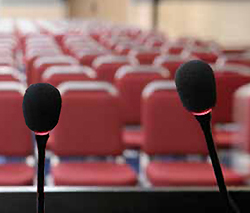
LAVALIER
Miniature condenser mics that clip onto clothing about 8 inches under the chin (or in the hair), allowing the talker freedom of movement.
Lavs have a tailored or contoured frequency response.
The high-end rises to compensate for the mic being off-axis to the mouth, where high frequencies are weak.
Sound diffraction of the body tends to cause a peak in the frequency response around 730 Hz, so some models include a dip filter at that frequency. The result is a more natural sound. It’s common to clip-on two of these mics for redundancy in critical applications.
Most models have an omnidirectional polar pattern. The advantages are less clothing noise, less wind noise, and more consistent sound levels when talkers turn their head.
Cardioid models are recommended when background noise or feedback are severe.
Some models are designed for use with wireless mic transmitters, and are equipped with mini-connector that mates with the transmitter’s mic connector.
Lavalier Applications
Church, broadcast, wandering lecturers, theatrical productionsExamples
❚ Audio-Technica AT803, AT831R, AT899, BP896 MicroPoint
❚ Audix L5
❚ Countryman B3, B6
❚ DPA 4060 and numerous variations
❚ Electro-Voice RE90Tx, RE90L
❚ Shure MC50B, MC51B, MX 183, SM93, WL183, WL93
❚ Sennheiser MKE Platinum-4-C, MKE 2 Gold
❚ Sony EM77B
HEADWORN
As the name implies, these small mics are worn on the head, so the user is free to move around while talking. A wire or plastic frame goes around the ear, and sometimes around the back of the head. A slim boom holds the microphone close to the edge of the mouth.
Because the mic is so close to the sound source, gain-before-feedback is excellent – even with omnidirectional models. It’s nearly invisible in use.
Several models are designed to work with beltpack wireless mic transmitters.
At the end of the mic cable, a miniature connector mates with the mic connector in the transmitter.
Headworn Applications
Worship, lecturers, presenters, actors, singers, health club (aerobics and yoga instructors)Examples
❚ Audio-Technica ATM73a, ATM75, BP892 MicroSet
❚ Countryman E6 and E2 Earset
❚ DPA d:fine
❚ Electro-Voice RE97Tx and RE97-2Tx
❚ Sennheiser HSP 2, HS 2, Ear Set 4, Ear Set 1
CHOIR/HANGING
Small, unidirectional condenser mic capsules at the end of long cables, typically hung near a choir or actors upstage. The mic cable usually carries a mediumimpedance unbalanced signal from the mic capsule.
At the end of the cable is an XLR connector or small chassis. Inside the connector or chassis, a circuit provides a low-impedance balanced output and converts phantom power into DC bias for the microphone capsule.
The polar pattern is cardioid, supercardioid or hypercardioid to reduce feedback, and the frequency response has a small rise at high frequencies to compensate for being off-axis to the mouth.
Generally, use one microphone in the center of every 20- to 30-foot span of singers. A choir of 30 to 45 voices should need only two or three mics. Place them about 18 inches in front of the first row of singers and about 18 inches above the head height of the back row.
The mics are raised so that the front row is not too loud relative to the back row. Run a fishline between side walls to anchor the mics so they don’t rotate.
If it’s inconvenient to hang choir mics, consider using mics mounted to thin carbon-fiber booms on mic stands, such as the Audix Micro- Boom, AKG GN155 CHOIR boom stand, CAD (Astatic) 2700VP or 1700VP. The latter models have continuously variable polar patterns.
Although hanging mics can be used for overhead pickup of a conference, this application is not recommended. The mics are usually too far from the talkers, and the resulting sound tends to be muddy and noisy with poor gain-before-feedback.
Choir/Hanging Applications
Choirs, actors who are upstage, security-surveillanceExamples
❚ AKG CMM 99, HM 1000 hanging module with CK capsules
❚ Audio-Technica ES933C, ES933H, U853 Series
❚ Audix ADX40
❚ Countryman Isomax 2
❚ Earthworks C30/C
❚ Electro-Voice RE90H and RE92H
❚ Shure MX202
Bruce Bartlett is a recording engineer, live sound engineer, microphone design engineer (www.bartlettmics.com), and audio journalist. His latest books are “Practical Recording Techniques 5th Edition” and “Recording Music On Location” (Focal Press).



